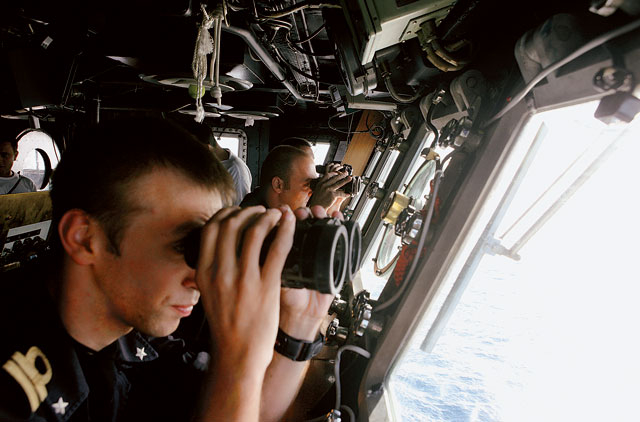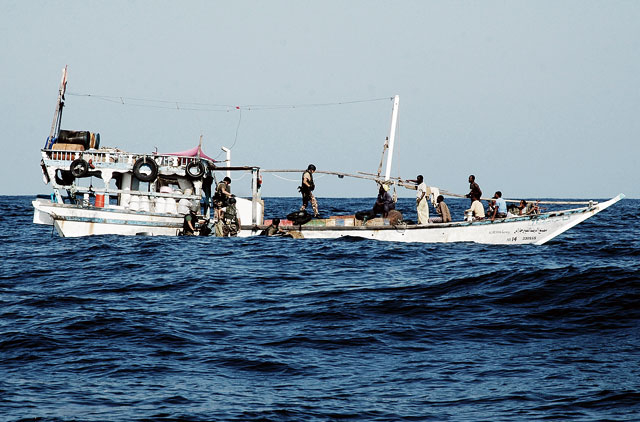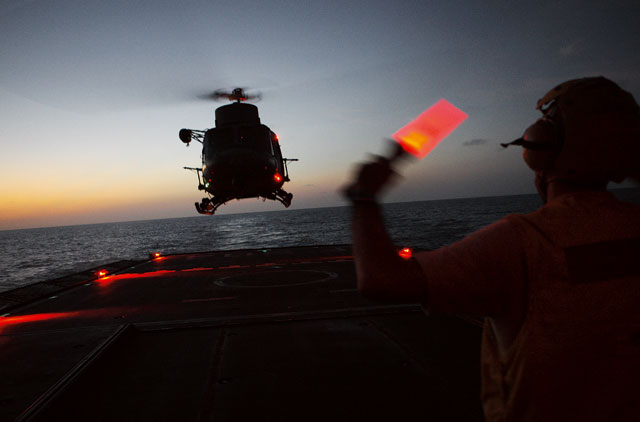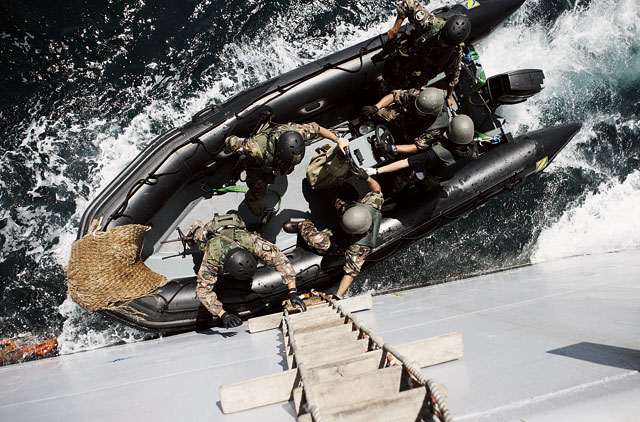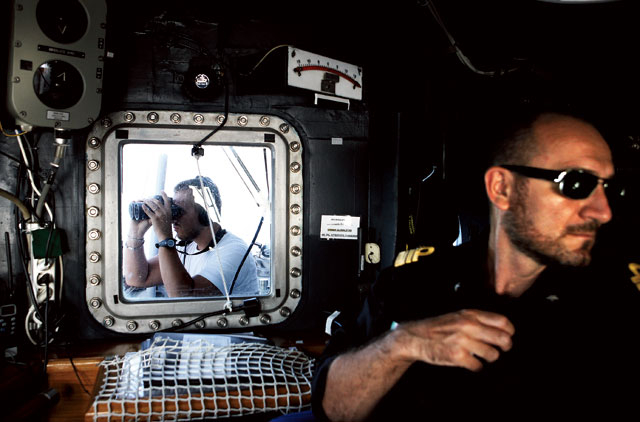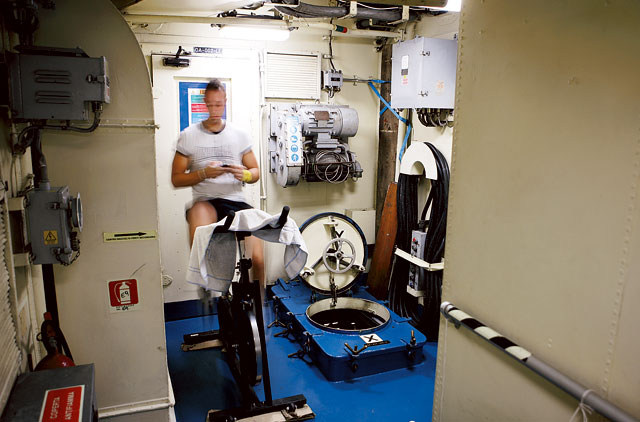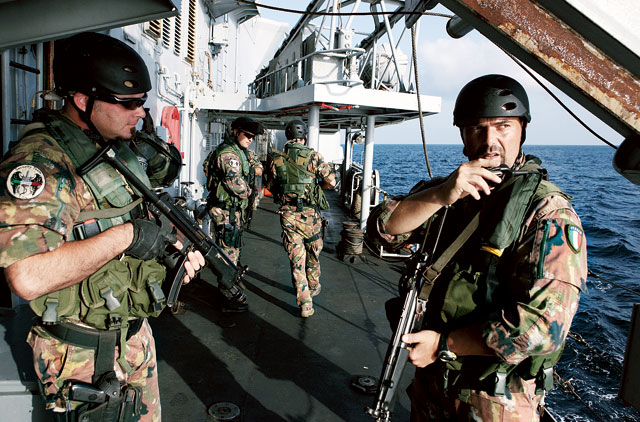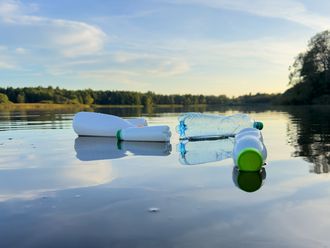
On one side is the defence. The Bersagliere is an Italian Navy frigate, 113 metres long with a crew of 188 men and impressive firepower: a 25-tonne 127/54 cannon able to pulverise a target more than 100 kilometres away; two 40/70 cannons; two anti-aircraft and anti-ship defence systems with a total of 24 missiles; two heavy Browning machine guns; two 20/70 machine guns; four 7.62 calibre MG machine guns mounted on a helicopter; and everything is controlled from a state-of the-art electronic warfare centre.
On the other side is the threat: a dhow, a wooden cargo barge seen throughout the Indian Ocean and Arabian Gulf, built by hand in the same way as it would have been 1,000 years ago; hewn with an axe wielded by a Somali craftsman, and powered by a rusty diesel motor that came out of a truck. On board this dhow is a pair of skiffs or fast speedboats, grappling hooks attached to rope for boarding raids, some ancient AK-47 rifles, perhaps a Soviet-made RPG launcher, some meagre provisions, drinking water, and a crew composed of half a dozen men with very little left to lose. They are the pirates of the new millennium.
The pirates are the reason for Operation Ocean Shield, which was launched by Nato in August 2009 to counter piracy using Task Force 508: five warships (including the Bersagliere as from October 2010) and the Dutch submarine Zeeleeuw. The task force patrols the waters around the Horn of Africa, attempting to deal with the rising tide of pirates who originate from the Somali coast, and who in the last few years have caused devastating damage to merchant shipping and to global commerce – amounting to around $16 billion (Dh58 billion) according to a report commissioned by the US Congress. In 2008 alone, according to the Kenyan Foreign Ministry, these pirates netted more than $150 million in money paid out by the owners of the seized ships. Given these figures, the necessity for a mission such as Ocean Shield is clear, even if it costs $350 million a year.
From the bridge of the Bersagliere, with 2,500 tonnes of steel slicing through the ocean beneath you and nine metres of cannon aimed at the horizon, the waters of the Gulf of Aden don’t seem terribly hostile. The ship patrols unceasingly, first in a southwesterly direction, then northeast, then southwest again, sailing at 12 knots between the coasts of Somalia and Yemen, always with the same daily routine. Every morning at 5am the flight unit prepares the helicopter – an AB212 modified with bulletproof Kevlar panels – for patrol. Takeoff is at around 6am. On board are two pilots and a radar operator, who if needed is also the machine gunner. Dawn and dusk are the pirates’ preferred moments for attack: there is enough light for them to identify a vessel as a cargo ship and not to risk boarding a warship by mistake – as happened in 2009 with the French Navy ship Somme, with disastrous consequences for the pirates. While the helicopter is in flight, the crew are on full alert.
At 8am the quick reaction force, a squad of ten commandos from the San Marco regiment, goes on standby, ready to set out in a rubber dinghy within minutes to intercept a suspicious dhow. Meanwhile, 180 men keep the ship running with clockwork precision – in the command centre and on the bridge, in the electronics room where the radar and weapons control systems are located, in the galley, in the helicopter hangar, in the infirmary, and in the engine room where two diesel motors produce 8,000 horsepower, and two aeronautical turbines produce 50,000.
Like the internal mechanism of a clock, life for some on board can end up being monotonous. The ship is superbly conceived, and every spare space has been turned into a gym with cycles and weights for releasing tension during down times. In the afternoon the flight deck becomes a jogging track – albeit a short one. The commandos, many of them veterans of Afghanistan and Iraq, shake their heads saying, “It was better there – at least something was always happening.”
What can happen here is they come across a dhow sailing 100 or 200 miles from the coast that may be innocuous in appearance, but carries a desperate enemy. The rules of engagement mean treating every dhow as if it has the most dangerous kind of armed men on board: those with absolutely nothing to lose.
A pirate dhow can usually be spotted from a distance by several distinguishing features. It has at least a pair of skiffs on the bridge, six or seven crew on board, no flag, and a plastic sheet spread out on deck. The sheet is the most chilling detail, not for its main function – hiding the crew and protecting them from the salty spray– but for its secondary role.
“The pirates are so hungry,” the commander of the Bersagliere, Gennaro Falcone says, “they often travel 500 to 600 miles from the coast, with only enough fuel for the outward journey. If the attack succeeds, they take possession of another ship and all is well. If it fails, or if they do not achieve their objective before the fuel runs out, the sheet becomes a sail, and they remain at the mercy of the wind. Ironically, if they throw their weapons into the sea, as does happen, under international shipping law they are in effect shipwrecked, and we – the people who want to arrest them, or the cargo vessels they were planning to raid – are obliged to rescue them.” Dealing with a suspect dhow always follows the same pattern. The frigate stays at a safe distance – a desperate man armed with an RPG might choose to die taking as many others with him as possible.
Then a marksman on the flight deck keeps the boat in the telescopic sights of his rifle, and the commando squad, armed to the teeth, approach the dhow in rubber dinghies to inspect it.
Besides weapons for responding to attacks, they also carry bottles of water and cigarettes. If the dhow is a fishing boat, as it often is, these are gifts for the crew, always appreciated and nearly always exchanged for fresh-caught shark and swordfish. The dhow is still photographed and – as they say in the control room – ‘tagged’ (electronic warfare using the language of Facebook, or is it the other way around?). It’s then added to the computer system that the ships of Task Force 508 use to exchange information in real time, to avoid it having to be stopped a second time.
The real bureaucratic nightmare comes if the soldiers discover a raiding kit on the vessel during the on-board inspection. At that point the commander must secure the dhow, arrest the crew – the Bersagliere has rope cages, which are rudimentary, but occupy minimal space and serve the task well – and organise a video conference trial, with a defence counsel and a magistrate who, on the basis of the evidence, will decide whether or not to convict.
If found guilty the pirates are held on board until the ship returns to its native country where they will serve their sentences, or be transferred, in a legal process that is not always successful, to a prison in Djibouti, the Seychelles or Kenya. These are regional countries that have signed an agreement with the European Union, which allows a third party to punish the pirates’ crimes on their behalf.
“However,” Falcon says, “ours is more a preventative policing task than anything else: our presence in the Gulf of Aden serves to reassure the cargo vessels that cross it and to dissuade pirates from assaulting them. But at the same time, we must be careful not to become an annoyance to local traffic, like the fishing boats and cargo dhows, and that’s why we give them something after every spot check. It’s a way to excuse ourselves for the time we cost them.” And time here, unlike in many other military operations, is literally money.


